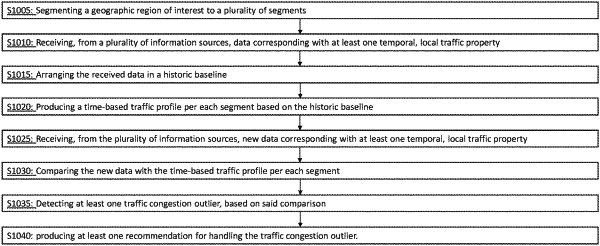| CPC G08G 1/0145 (2013.01) [G06F 17/18 (2013.01); G06N 3/08 (2013.01); G06N 5/046 (2013.01); G06N 20/00 (2019.01); G08G 1/0129 (2013.01); G08G 1/0133 (2013.01)] | 21 Claims |

|
1. A method of detecting and handling traffic congestion outliers by at least one processor, the method comprising:
receiving, from a plurality of information sources, data corresponding to at least one temporal, local traffic property;
producing a local, time-based traffic profile based on the received data, wherein the local, time-based traffic profile reflects historic states of the at least one temporal, local traffic property;
receiving, from at least one information source, new data corresponding to the at least one temporal, local traffic property;
generating a score for the new data by:
comparing the new data to the local, time-based traffic profile so as to generate one or more severity rates, each severity rate corresponding to exactly one of the at least one temporal, local traffic property,
assigning a weight to each severity rate, and
accumulating the one or more severity rates according to the respective weights, to produce an overall accumulated weighted score as the score;
if the score surpasses a threshold, then identifying the data as originating from a local, temporal traffic congestion outlier;
clustering a plurality of segments identified as having a traffic congestion outlier to a plurality of clusters;
assigning a cluster score to each cluster, according to at least one severity rate of member congested segments;
producing a traffic report, comprising a geographic representation of the plurality of clustered segments and the clusters' respective cluster score; and
transmitting a recommendation to a user device, based on the traffic report, wherein the recommendation includes at least one of: a geographic location of a cluster of the plurality of clusters, a time-based origin of the cluster, and a cluster score of the cluster.
|